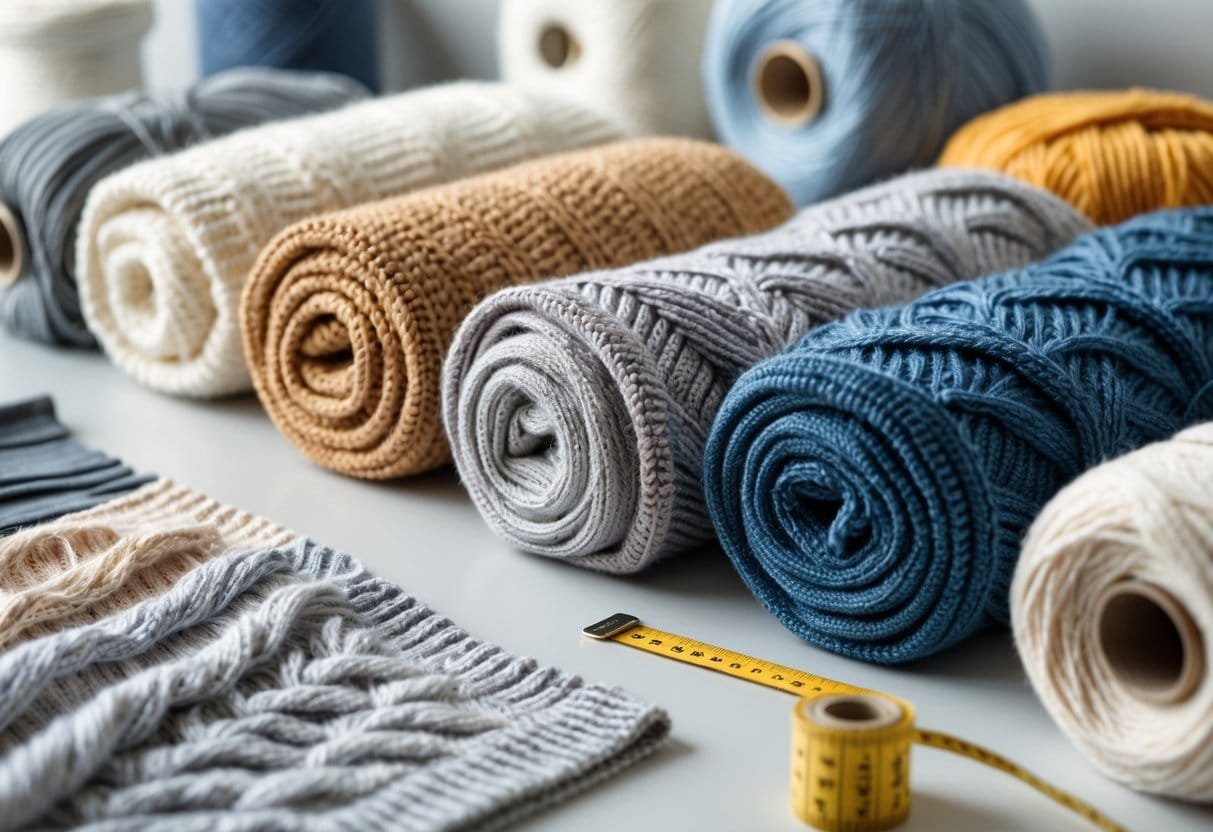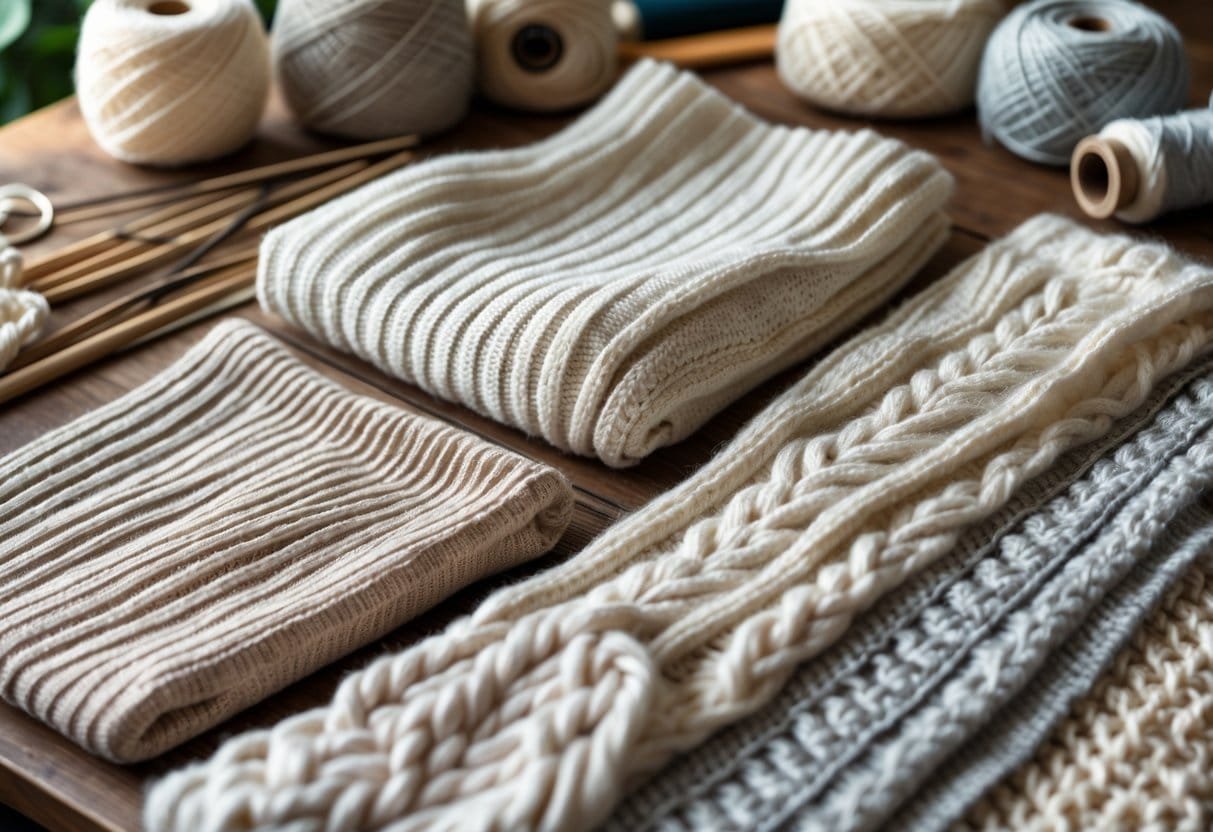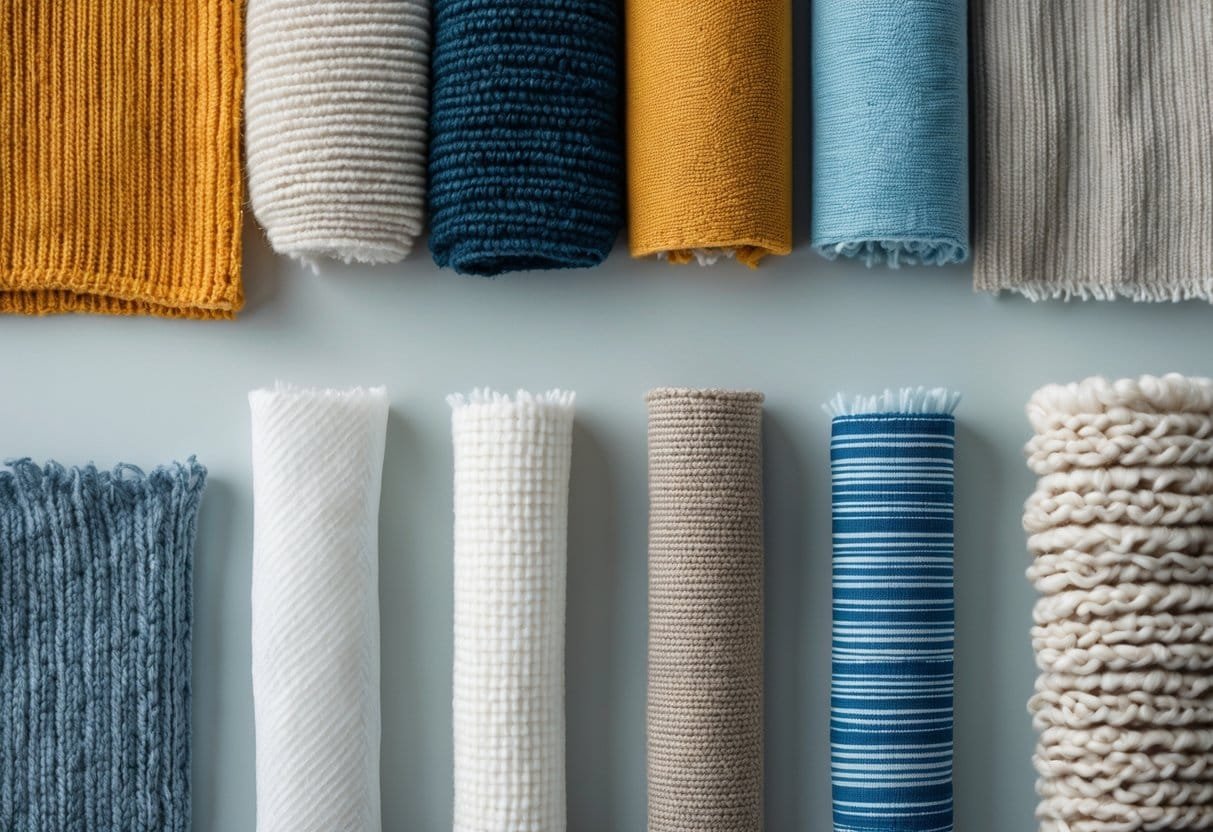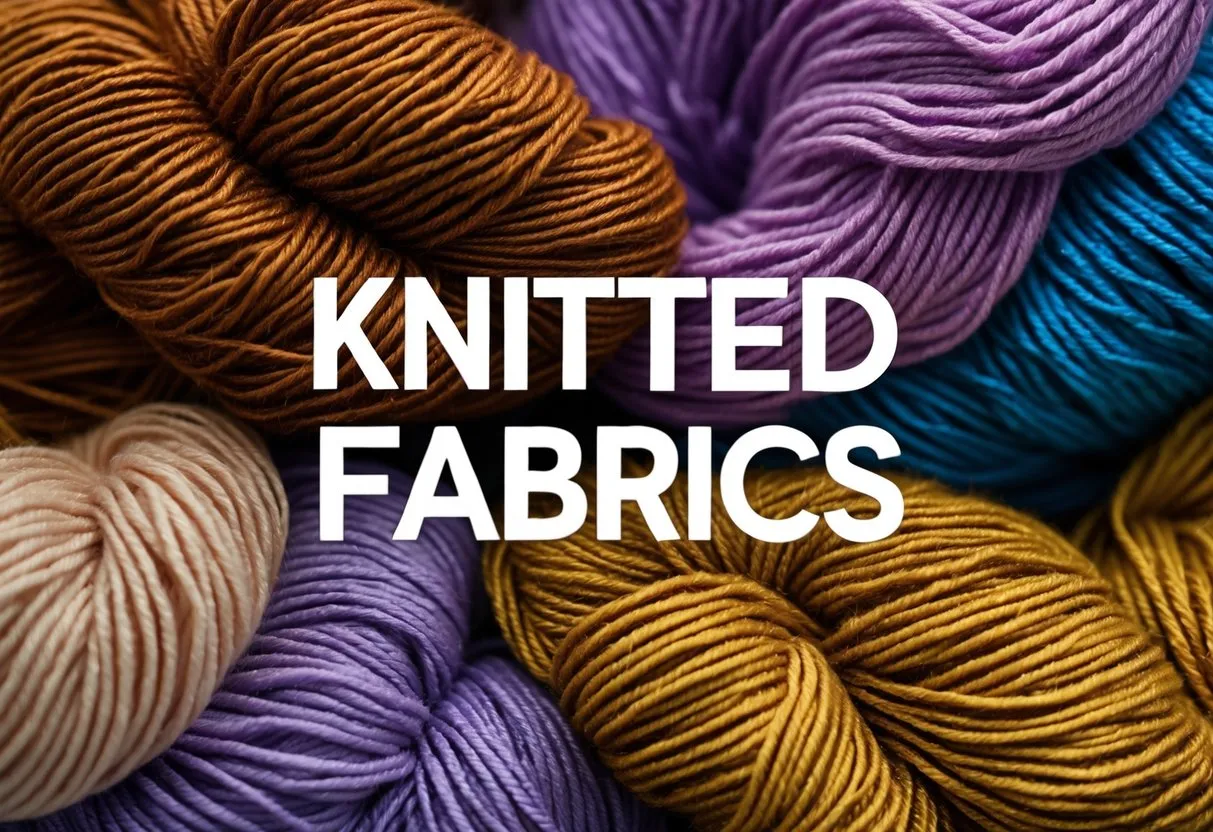Types of Knitted Fabrics And What They’re Used For
Knitted fabrics are made by looping yarns together, creating a flexible and often stretchy material. They come in many types, each with unique structures and uses, making them ideal for everything from everyday clothing to specialized sportswear. This variety allows designers and manufacturers to choose the best knit fabric depending on the garment’s needs, whether comfort, durability, or appearance.

The most common types include weft knits and warp knits, which differ in how the yarn loops are formed. These fabrics vary in weight, texture, and stretch, influencing their function and feel. Knitted fabrics are also popular because they are often quicker and cheaper to produce than woven fabrics, with natural wrinkle resistance.
Understanding the differences in knit types helps explain why some are better suited for certain uses, like soft jerseys for t-shirts or sturdy rib knits for collars and cuffs. By exploring their structures and typical applications, one can better appreciate how knitted fabrics shape the way clothes are made and worn.
Table of Contents
Foundations of Knitted Fabrics

Knitted fabrics differ from woven fabrics in how they are made, their structure, and the materials used. Understanding these differences helps in choosing the right fabric for specific uses, whether for clothing, home textiles, or technical applications. Key terms and common materials explain the basic properties and performance of knitted fabrics.
What Sets Knitted Fabrics Apart From Woven Fabrics
Knitted fabrics are made by interlocking yarn loops, while woven fabrics are created by crossing yarns at right angles. This looped structure gives knits more stretch and flexibility. They can expand and recover better, making them ideal for clothing that requires comfort and movement.
Knits are generally softer and more breathable than woven fabrics. However, they can stretch out of shape more easily and may be less stable dimensionally. Knitted fabrics can be produced faster and often at lower cost due to simpler machinery setups.
The elasticity in knits comes from the loop structure itself, not just the yarn used. This allows knits to fit closely to the body or provide easy movement in sportswear or underwear, unlike the firmer feel of most woven fabrics.
The Structure and Terminology of Knitted Textiles
Knitted textiles consist of loops arranged either horizontally (weft knitting) or vertically (warp knitting). Weft knits are made row by row with one yarn, creating fabrics like single jersey and rib knit. They tend to be stretchier but less stable. Warp knits form loops in columns using many yarns, producing more stable fabrics like tricot and raschel.
Key terms include courses (rows of loops) and wales (columns of loops). The type of knit affects properties like stretch, weight, and durability. Knitting machines vary: circular machines create seamless tubes, while flat machines produce fabric panels.
This structure explains why knitted fabrics can be thin or thick, smooth or textured, depending on the loop arrangement and stitch type chosen.
Overview of Common Knit Materials
Knitted fabrics use a wide range of fibres, from natural ones like cotton and wool to synthetic fibres such as polyester and nylon. Cotton knits are soft, breathable, and popular in casual wear. Wool knits provide warmth and moisture control, ideal for sweaters.
Synthetic yarns like polyester increase durability, elasticity, and quick drying, making them common in sportswear. Blends combine fibres to balance comfort, stretch, and performance.
Sustainable fibres such as organic cotton and recycled polyester also grow in popularity, offering environmental benefits without sacrificing fabric qualities like softness or strength. Each fibre choice impacts the feel, durability, and care of the knitted fabric.
Core Types of Knitted Fabrics

Knitted fabrics come mainly in two types, defined by how yarns form loops in the fabric. Each type has unique qualities that affect stretch, strength, and appearance. Their production methods also differ, influencing the kinds of garments made from them.
Weft Knitting
Weft knitting creates fabric by looping yarn horizontally, row by row. It often forms tubes and uses a single yarn or multiple yarns fed into circular machines. This method builds each new row based on the previous one’s loops.
Common weft knit fabrics include single jersey, rib knit, and purl knit. Single jersey has a smooth face side and a looped back side. Rib knits use needles on two beds, creating stretchy fabric often used for cuffs and collars. Purl knits have stitches on both sides and stretch well lengthwise.
Weft knits are flexible, soft, and easy to produce quickly. They tend to curl at edges and are popular in T-shirts, sweaters, undergarments, and sportswear.
Warp Knitting
Warp knitting loops yarn vertically, moving in a zigzag along the fabric’s length. Unlike weft, this uses multiple yarns simultaneously, typically run on specialized machines.
Warp knits are more stable and less stretchable than weft knits. They do not easily run or ladder, making them durable.
Common warp knits include tricot, which is lightweight and smooth, and raschel, which often has lace-like patterns and uses thicker yarns. These fabrics are common in swimwear, lingerie, and home textiles.
The machines involved allow for complex patterns and fast production, making warp knitting vital in industrial textile work.
Popular Knitted Fabric Constructions

Knitted fabrics differ by how the loops of yarn are arranged, which gives each fabric unique stretch, texture, and strength. These features decide where the fabric works best, from casual wear to structured clothing.
Jersey Knit
Jersey knit is the most common knitted fabric. It is made from a single yarn looped continuously in one direction. This structure creates a smooth surface on the front and a slightly bumpy texture on the back.
It has moderate stretch mostly across the width, making it comfortable and flexible. Jersey knit is usually lightweight to medium weight and made from cotton, wool, or synthetic fibers.
Common uses include T-shirts, underwear, and tops because it is soft, breathable, and easy to sew. Its smooth look and slight sheen make it suitable for everyday clothing that needs gentle stretch and comfort.
Rib Knit
Rib knit features vertical ridges formed by alternating knit and purl stitches. This creates a fabric with high elasticity in both directions, making it fit snugly without losing shape.
Its raised texture traps air, which adds warmth. Rib knits are thicker than jersey and have stronger recovery, meaning they return to their original shape after stretching.
They are often found in collars, cuffs, waistbands, socks, and tights. Rib knit is the go-to fabric when firmness and stretchiness are needed in specific garment parts to improve fit and durability.
Interlock Knit
Interlock knit is a double-knit construction with two layers of jersey knit joined face-to-face. This creates a very smooth, firm fabric with a soft hand feel on both sides.
It is thicker and more stable than single jersey. The fabric offers excellent stretch and recovery while maintaining durability.
Typically made from cotton or blends, interlock is breathable and soft enough for activewear and leggings. Its balanced structure prevents curling at the edges, making it easier to sew and ideal for fitted clothing requiring smooth finish.
Double Knit
Double knit fabric is made on special machines that produce two layers of fabric joined together. This results in a thicker, heavier fabric with little curl at the edges.
It is sturdy with moderate stretch, offering more support than single jersey or rib. The texture often shows knit stitches on both sides, sometimes forming patterns.
Double knit is used in garments like dresses, skirts, and jackets. Its weight and structure provide shape and warmth, making it suitable for form-fitting and outerwear pieces that need body and stability.
Materials Used in Knitted Fabrics

Knitted fabrics are made from both natural and synthetic fibers. Each fiber type affects the fabric’s feel, durability, stretch, and care needs. Choosing the right material depends on where and how the fabric will be used.
Natural Fibers: Cotton, Wool, Linen, Silk
Cotton is a soft, breathable fiber widely used in knitted fabrics for casual wear. It absorbs moisture well, making it comfortable in warm climates. Cotton knit fabric is common in t-shirts and baby clothes because of its softness and durability.
Wool provides excellent warmth and insulation. It is often used in sweaters and winter accessories. Wool knit fabrics trap air to keep heat in, but they may require special care to prevent shrinking.
Linen is lighter and cooler than cotton, with a natural texture. It is breathable and tends to wrinkle, so linen knits are best for summer garments and lightweight clothing.
Silk knit fabric feels smooth and luxurious with a natural sheen. It drapes well and is used for dresses and lingerie. Silk knits are delicate and often require careful washing.
Synthetic Fibers: Polyester, Nylon, Acrylic, Spandex, Tencel
Polyester is strong, wrinkle-resistant, and dries quickly. It is commonly blended with other fibers in activewear for durability and moisture-wicking. Polyester knits hold their shape well but are less breathable than natural fibers.
Nylon offers good strength and stretch. It is often combined with other yarns in sportswear and hosiery to increase elasticity and durability.
Acrylic mimics wool’s warmth but is lighter and easier to care for. Acrylic knit fabric is used in economical sweaters and accessories, as it resists moths and mildew.
Spandex is valued for its exceptional stretch and recovery. It is a key part of sportswear and leggings, often blended with other fibers to add flexibility.
Tencel is a semi-synthetic fiber made from wood pulp. It is breathable, soft, and eco-friendly. Tencel knits are smooth and comfortable, often used for casual and sustainable fashion.
Key Properties and Benefits of Knitted Fabrics

Knitted fabrics offer unique qualities that make them suitable for many types of clothing. Their stretchiness, breathability, durability, and appearance contribute to their wide use in fashion and everyday wear.
Stretch and Recovery
Knitted fabrics are known for their excellent stretch. The loops in the fabric allow it to stretch in multiple directions, especially sideways. This flexibility supports body movement and provides comfort in garments like sportswear and underwear.
Recovery refers to the fabric’s ability to return to its original shape after being stretched. Good recovery in knits prevents sagging and bagging over time. For example, rib knits have strong recovery due to their loop structure, making them ideal for cuffs and waistbands that need to maintain shape.
Stretch and recovery levels vary by knit type and yarn used. A combination of fiber content and stitch pattern affects how much the fabric can stretch and bounce back.
Moisture-Wicking and Breathability
Many knitted fabrics allow air to pass through easily, helping with ventilation. This breathability helps keep the wearer cool and comfortable, especially during physical activity.
Some knits also have moisture-wicking properties, which means they draw sweat away from the skin to the fabric’s surface where it can evaporate. This feature is common in sportswear knits made from synthetic fibers like polyester or blends designed for activewear.
Moisture-wicking combined with breathability reduces discomfort and skin irritation. Cotton knits breathe well but do not wick moisture as efficiently as synthetic knits. The choice depends on the intended use of the fabric.
Durability and Ease of Care
Knitted fabrics tend to be durable due to their construction. The loops provide natural elasticity, which reduces tearing under stress compared to woven fabrics.
Care is generally simple. Many knits are machine washable and resist wrinkles, reducing the need for ironing. However, some knit types may shrink if washed improperly, so following care instructions is important.
Serger stitching or zigzag sewing techniques are often used to handle knits well during garment construction, helping seams last longer without puckering or stretching out of shape.
Colorfastness and Drape
Colorfastness is the fabric’s ability to retain color when exposed to washing, sunlight, and friction. Knits vary in colorfastness depending on the dyeing process and fiber type. Polyester knits typically have better color retention than cotton.
Drape describes how fabric falls or hangs on the body. Knit fabrics generally drape softly and follow body contours better than woven fabrics. Certain knits, like ITY or ponte, offer a balance of drape and structure, making them suitable for dresses and formal wear.
The choice of knit affects how garments look and feel. Fabrics with good drape enhance silhouette while maintaining comfort.
Applications and Uses of Knitted Fabrics

Knitted fabrics are valued for their stretch, comfort, and durability. They fit closely to the body and allow for easy movement, making them ideal in many fields. Their ability to absorb moisture and retain shape adds to their wide range of applications.
Apparel: T-Shirts, Activewear, and Sportswear
Knitted fabrics are common in everyday clothing like t-shirts because of their softness and breathability. They keep the wearer cool and comfortable, which is why many casual shirts use jersey knit fabrics.
Activewear relies on knitted fabrics for their ability to stretch and move with the body. Many sports clothes include moisture-wicking and quick-drying properties for better performance. These fabrics also offer good thermal insulation without bulk.
Sportswear uses advanced knitted technology like seamless and 3D knitting. This reduces seams and improves fit, lowering fabric waste and improving comfort. Knitted fabrics are now essential in the textile industry for making high-performance garments.
Home Textiles and Specialty Uses
Knitted fabrics are also found in home textiles such as blankets and cushion covers. Their softness and warmth make them popular for these uses.
Specialty knitted textiles appear in accessories like scarves and hats. Knitting’s flexibility allows for detailed patterns and textures not possible with woven fabrics.
In some industries, knitted fabrics serve medical or technical purposes. Their stretch and breathability are useful in medical supports and smart textiles that monitor body conditions. This expansion shows knitted fabrics’ versatility beyond fashion.
Comparing Knitted Fabrics With Other Fabric Structures

Knitted fabrics differ from woven and nonwoven fabrics in structure and use, influencing their performance and applications. Their unique looped construction affects stretch, strength, and breathability in comparison to the fixed yarns of woven fabrics or the bonded fibers of nonwovens.
Advantages and Disadvantages Versus Woven and Nonwoven Fabrics
Knitted fabrics offer greater stretch and flexibility due to their looped yarns. This makes them ideal for clothing that requires comfort and movement, like sportswear or casual apparel. They also tend to be more breathable than woven fabrics, which have tighter yarn structures.
However, knitted fabrics generally lack the strength and shape retention of woven fabrics. Woven fabrics have yarns crossing at right angles, making them stronger and better for durable items like denim jeans and workwear.
Nonwoven fabrics, like felt, differ completely by bonding or felting fibers together. Nonwovens can provide good insulation and barrier properties but lack stretch and durability, limiting them to specific uses such as filters or padding.
Special Cases: Felt and Denim
Felt is a nonwoven fabric made by matting and pressing fibers, so it does not have yarns or loops. This structure gives felt a dense, warm feel but it is not stretchy or strong. Felt is commonly used for crafts, insulation, or soundproofing.
Denim is a type of woven fabric, characterized by a diagonal ribbing from twill weave. It is known for its ruggedness and durability. Denim holds its shape well and is commonly used in jeans, jackets, and heavy-duty clothing.
Both felt and denim differ significantly from knitted fabrics. Felt lacks elasticity and structure, while denim is durable but less flexible. Knitted fabrics balance comfort and stretch but trade off on strength and rigidity.
Frequently Asked Questions
Knitted fabrics vary widely in texture, stretch, and durability. Their performance depends on factors like yarn type, knit structure, and intended use. Different knit fabrics suit distinct clothing needs, from casual wear to specialized garments.
What are the characteristics of different knitted fabrics?
Weft knits are stretchier and softer, often used for comfort wear. Warp knits are more stable and less stretchy, suitable for structured garments. Single jersey knit has good stretch but can curl at edges. Rib knits offer strong elasticity and recovery. Interlock knits are thicker and more stable with minimal stretch.
How is the performance and use of various knit fabrics determined?
Performance depends on yarn weight, knit type, and fabric density. Stretch and recovery affect comfort and shape retention. Durability matters for activewear and workwear. Breathability and wrinkle resistance guide choices for casual or formal wear. Stitch type influences fabric thickness and drape.
What are the common applications for circular knit fabrics?
Circular knits produce seamless tubes often used in t-shirts, hosiery, and activewear. They provide stretch and fit. This method is fast and cost-effective for mass production of soft, flexible garments.
Can you provide a comparison of the most popular knit fabrics?
Single jersey offers good stretch but may shrink and curl. Rib knit provides excellent stretch and shape retention. Interlock knit is thicker, stable, and resists stretching. Tricot (warp knit) is smooth, lightweight, and less stretchy. Raschel knits are intricate and strong with patterned textures.
Which knitted fabrics are best for specific fashion garments?
T-shirts commonly use single jersey. Sweaters and scarves are made from purl or rib knits for warmth and flexibility. Dresses often use ITY knit for flow or ponte for structure. Activewear relies on warp knits like tricot for durability and stretch.
How do warp knit and weft knit fabrics differ in use and structure?
Warp knits are made with yarns running vertically, making them more stable and less stretchy. They are machine-made and used for swimsuits, underwear, and sportswear. Weft knits have horizontal loops, giving them more stretch and softness, ideal for casual wear and fitted garments.







